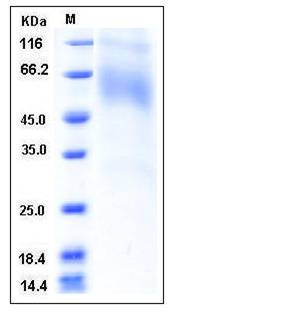Mouse MSR1 / CD204 / SCARA1 Protein (His Tag)
MRS-A,MSR,MSR-A,Scara1,Scvr,SR-AI,SR-AII
- 100ug (NPP3421) Please inquiry
| Catalog Number | P50129-M07H |
|---|---|
| Organism Species | Mouse |
| Host | Human Cells |
| Synonyms | MRS-A,MSR,MSR-A,Scara1,Scvr,SR-AI,SR-AII |
| Molecular Weight | The recombinant mouse MSR1 consists of 288 amino acids and has a calculated molecular mass of 32 KDa. |
| predicted N | His |
| SDS-PAGE |  |
| Purity | > 90 % as determined by SDS-PAGE |
| Protein Construction | A DNA sequence encoding the mouse MSR1 (AAH03814.1) extracellular domain (Trp 83-Val 354) was expressed, fused with a polyhistidine tag at the N-terminus. |
| Bio-activity | |
| Research Area | Immunology |Signal Transduction |Metabolism |Types of disease |Metabolism in Heart disease |
| Formulation | Lyophilized from sterile PBS, pH 7.4 1. Normally 5 % - 8 % trehalose, mannitol and 0.01% Tween80 are added as protectants before lyophilization. Specific concentrations are included in the hardcopy of COA. |
| Background | Macrophage scavenger receptor types I and II, also known as Macrophage acetylated LDL receptor I and II, Scavenger receptor class A member 1, CD204, MSR1 and SCARA1, is a single-pass type I I membrane protein which contains one collagen-like domain and one SRCR domain. Macrophages are distributed in all peripheral tissues and play a critical role in the first line of the innate immune defenses against bacterial infection by phagocytosis of bacterial pathogens through the macrophage scavenger receptor 1 (MSR1). MSR1 / SCARA1 is one of the membrane glycoproteins implicated in the pathologic deposition of cholesterol in arterial walls during atherogenesis. Two types of receptor subunits exist. These receptors mediate the endocytosis of a diverse group of macromolecules, including modified low density lipoproteins (LDL). MSR1 / SCARA1 is also involved in chronic inflammation which is a risk factor for prostate cancer. MSR1 1 gene was identified as a candidate susceptibility gene for hereditary prostate cancer and as a risk factor for sporadic prostate cancer. |
| Reference |
